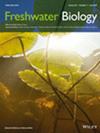使用除草剂和杀藻剂控制入侵水生系统中大型植物和藻华的食物网影响
IF 2.7
2区 生物学
Q2 ECOLOGY
引用次数: 0
摘要
考虑到水生植物(即大型植物)可能随着富营养化而扩大,湖泊和池塘通常使用除草剂来大面积杀死不需要的植物。在这样做的过程中,死亡的植物分解并释放出大量的营养物质,这些营养物质可以促进主要的藻华,随后通过施用杀藻剂来控制。群落结构的这些快速变化也可能促进其他变化,例如入侵物种的扩散。我们需要更多地了解除草剂和杀藻剂如何影响整个食物网,包括含有入侵物种的食物网。我们采用户外中生态社区来探索一种常见除草剂(氟立酮)和一种杀藻剂(硫酸铜;CuSO4)。群落包括藻类、浮游动物、欧亚千叶藻(狐尾藻)和两种本地蜗牛(尖螺和海螺)。我们进一步操纵入侵的中国神秘蜗牛(Cipangopaludina chinensis)的存在,以研究相同的化学物质如何改变其入侵群落的能力。令人惊讶的是,我们发现除草剂导致浮游植物减少40%,桡足类动物减少,可能是间接影响。添加CuSO4导致浮游植物数量减少60%,但周围植物数量没有减少,同时也导致枝海洋动物数量增加,桡足类和两种本地蜗牛物种数量减少。与此相反,入侵的中国神秘蜗牛没有受到杀藻剂的影响,但它降低了本地蜗牛的周生菌丰度和一种。总的来说,这些结果强调了检查多种人类影响(单独或组合)的重要性,以便更有效地评估人类活动对水生生态系统的计划和无意影响。本文章由计算机程序翻译,如有差异,请以英文原文为准。
Food-Web Impacts of Controlling Macrophytes and Algal Blooms Using Herbicides and Algicides in Invaded Aquatic Systems
- Given the expansion of aquatic plants (i.e., macrophytes) that can occur with eutrophication, lakes and ponds are often managed with herbicides to kill large areas of undesired plants. In doing so, the dead plants decompose and release large amounts of nutrients that can facilitate major algal blooms, which are subsequently managed by applying algicides. These rapid shifts in community structure might also encourage other shifts, such as the proliferation of invasive species. More understanding is needed about how herbicides and algicides affect entire food webs, including food webs containing invasive species.
- We employed outdoor mesocosm communities to explore the community-wide effects of a common herbicide (fluridone) and an algicide (copper sulphate; CuSO4). Communities included algae, zooplankton, Eurasian milfoil (Myriophyllum spicatum) and two native snails (Physa acuta and Helisoma trivolvis). We further manipulated the presence of the invasive Chinese mystery snail (Cipangopaludina chinensis) to examine how the same chemicals might alter its ability to invade a community.
- Surprisingly, we discovered that the herbicide caused a 40% reduction in phytoplankton and a decline in copepods, likely as an indirect effect. Adding CuSO4 caused a 60% reduction in phytoplankton but no reduction in periphyton, while also causing an increase in cladocerans and declines in copepods and the two native snail species. In contrast, the invasive Chinese mystery snail was unaffected by the algicide, while it drove down the abundance of periphyton and one of the native snails.
- Collectively, these results highlight the importance of examining multiple human impacts—alone and in combination—to more effectively assess the planned and inadvertent effects of human activities on aquatic ecosystems.
求助全文
通过发布文献求助,成功后即可免费获取论文全文。
去求助
来源期刊

Freshwater Biology
生物-海洋与淡水生物学
CiteScore
5.90
自引率
3.70%
发文量
162
审稿时长
2 months
期刊介绍:
Freshwater Biology publishes papers on all aspects of the ecology of inland waters, including rivers and lakes, ground waters, flood plains and other freshwater wetlands. We include studies of micro-organisms, algae, macrophytes, invertebrates, fish and other vertebrates, as well as those concerning whole systems and related physical and chemical aspects of the environment, provided that they have clear biological relevance.
Studies may focus at any level in the ecological hierarchy from physiological ecology and animal behaviour, through population dynamics and evolutionary genetics, to community interactions, biogeography and ecosystem functioning. They may also be at any scale: from microhabitat to landscape, and continental to global. Preference is given to research, whether meta-analytical, experimental, theoretical or descriptive, highlighting causal (ecological) mechanisms from which clearly stated hypotheses are derived. Manuscripts with an experimental or conceptual flavour are particularly welcome, as are those or which integrate laboratory and field work, and studies from less well researched areas of the world. Priority is given to submissions that are likely to interest a wide range of readers.
We encourage submission of papers well grounded in ecological theory that deal with issues related to the conservation and management of inland waters. Papers interpreting fundamental research in a way that makes clear its applied, strategic or socio-economic relevance are also welcome.
Review articles (FRESHWATER BIOLOGY REVIEWS) and discussion papers (OPINION) are also invited: these enable authors to publish high-quality material outside the constraints of standard research papers.
 求助内容:
求助内容: 应助结果提醒方式:
应助结果提醒方式:


